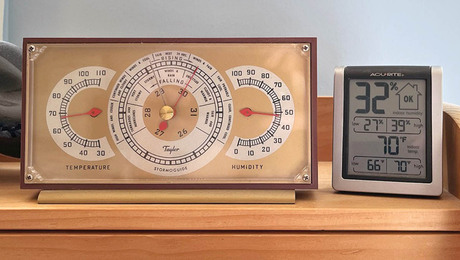Basement insulation / vapour barrier issue – PLEASE HELP!
Hello,
I contracted out the build of my own home a few years back and did my best to “build it right” where I could afford to do so. I live in Southern Ontario Canada, so I experience all 4 seasons with a moderate winter. The house has a full 8′ basement that consists of a poured wall that has a waterproofing membrane on the outside, 2×4 framing on the insde of the poured walls with mineral wool insulation (Roxul) which is doesn’t lose it’s R Value if it gets wet, then finally a vapour barrier consisting of 6 mil poly. As per code, i insulated the full wall to the floor of the basement.
I recently noticed moisture on the inside of the vapaour barrier in the basemet (i.e. warm side) and this is the first time I have ever seen this. I removed the vapour barrier in the spot with the most moisture and the insulation was dry, apart from a bit of moisture where the vapour barrier made contact with the insulation, the studs were dry and the foundation wall was dry. I came to the conclusion that the cold basement air (since I have the A/C going constantly since it’s been such a hot, humid summer here) is hitting the warm air coming from the outside / foundation wall and this is creating moisture.
This insulation technique was consistent with code and bullding techniques in the area, although some builders put Tyvek on the inside of the poured wall before the walls are strapped and insulated. I didn’t Tyvek the inside of the poured wall, but I don’t think this would help wanyways since you would still have warm air meeting cold air and with no where for the moisture to go, it would still accumulate on the vapour barrier.
I have talkd to a few contractors and they are telling me I need a de=humidifier down there and that will take care fo the problem, but I don’t think this would work either. The vapour barrier doesn’t breathe, so a de-humidified woudln’t be able to remove the moisture on the inside of the 6 mil poly.
I looked around for clues as to what is happening and I noticed that my basment (which is about 1,350 ft2 – I have a 2,700 ft2 two storey) only has one return for the HVAC which seems way too light and perhaps that is why I have the issue since the cold air stays in teh basement too long. Oh yeah, my basmenet is probably 6 – 8 degrees colder than the main floor. Then I checked the duct work above the furnace and it’s freezing which is telling me the A/C unit has to work to hard to get the house to an appropriate temperrature which is telling me my sheet metal installer was a hack.
Now i’ve came to the conclusion I have to rip out the vapour barrier and let it dry out, but I want to fix the problem. Does anyone have any clues or possible suggestions to fix this issue. My basement is unfinished, but I still don’t want the moisture since it will eventually rot my studs. Would adding a couple return vents and re-installing the vapour barrier fix this issue? If so, can I go after the HVAC contractor and get him to pay to re-install the vapour barrier. It’s not a ton of money, but it’s stil about $750 when you are all done with re-installation. Any help would be greatly appreciated since I’m getting really worried about this. Thanks in advance for your help and sorry for the long thread.


















Replies
Have a look here:
http://www.buildingscience.com/resources/more-topics/vapor_barrier_code_changes
...and in other areas of this site.
Two separate problems here: vapor barrier and possibly inadequate return air.
First, the vapor barrier: although the concrete wall was treated with a waterproof membrane, there is still the potential for moisture to saturate the concrete, at least enough to create vapor pressure toward the inside of the basement. That moisture can't dry to the outside; it must be able to dry to the inside--so, remove the 6-mil poly and finish the basement walls with vapor-permeable materials and paint.
Inadequate return air is very common. But do a simple test to see what's happening: with the furnace blower running, shut the door that separates the basement from the upper floor while standing on the side of the door that opens to the upper floor--feel along the gap at the bottom of the door. If you feel air rushing thru, it means the return air opening in the basement is not large enough to handle the air being pushed out by the basement supplies.
It's also possible that the return air for the entire house is undersized, or that the A/C unit is oversized--either of these would cause the condidtioned air to be too cold, and possibly freeze the evaporator coil.
Sounds to me
like the vapor barrier is in the wrong place, and that it should be against the concrete, at least during air conditioning season.
I recently noticed moisture on the inside of the vapaour barrier in the basemet (i.e. warm side)
I assume by this you mean the moisture in on the side of the concrete, not in the room.
If so, as you now have it, the cold air in the basement is causing moisture to condense on the VB, probably drawing that moisture out of the concrete. Sounds like it's not a lot of moisture, and it may never do any harm.
If the VB were against the concrete, it wouldn't get as cold (protected by the insulation) and even if condensation occurred it would stay against the concrete.
Now, in the winter, would this reverse? Would the concrete get cold enough to cause condensation on the room side of the VB?
Best case might be to remove all, install foam insulation board against the concrete, install the studs over the foam, then the fiberglass, then your finish material.